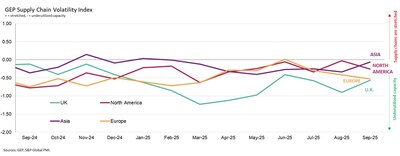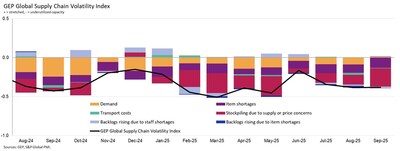CHINA DRIVES STRONGEST GROWTH IN GLOBAL FACTORY PURCHASING SINCE MID-2022, WHILE NORTH AMERICAN MANUFACTURERS COOL IN SEPTEMBER: GEP GLOBAL SUPPLY CHAIN VOLATILITY INDEX
Rhea-AI Summary
GEP Global Supply Chain Volatility Index (SPGI) — Sept. 10, 2025: the index was essentially unchanged at -0.38 (Aug: -0.39), signalling global supply chains remain underutilized. China drove the report, with factory purchasing rising at the fastest pace since mid-2022 and pushing Asia toward near-full utilization. North America cooled as tariff delays and a softer economic outlook reduced purchasing and inventory restocking. Europe fell to its weakest level since March; the UK improved to -0.57 from -0.90 but stayed weak. Material shortages and labor constraints eased in September.
Positive
- Index stable at -0.38 in September 2025
- China purchasing strongest since mid-2022
- Asia supply chains near full utilization
- Global material shortages decreased in September
Negative
- North American manufacturers reduced purchasing due to tariffs
- Europe supply-chain activity weakest since March 2025
- UK manufacturing still weak at -0.57
Insights
China's purchasing surge offsets weaker North American and European demand, leaving global capacity underused overall.
GEP Global Supply Chain Volatility Index remains below zero on
North America showed reduced purchasing and inventory accumulation due to tariff delays and a softer outlook, while Europe registered its weakest supply‑chain activity since March. The report also notes easing material and labour shortages and transportation costs at normal levels, which reduces near‑term supply constraints.
Key dependencies and near‑term risks include continued Chinese demand sustaining Asian utilization and tariff/disruption dynamics constraining North American procurement. Watch the next data release on
-
Chinese manufacturers sharply increased purchasing in September, propelling
Asia's supply chains to their busiest level since June 2022. - In contrast, tariff-related disruptions and a softer economic outlook curbed North American manufacturing activity.
-
Europe's recovery remains sluggish, with supply chains operating at their weakest since March.
However, Chinese factories report a strong rise in purchasing, pushing global manufacturing procurement activity up at the fastest rate since mid-2022. This expansion pushed
In sharp contrast, North American supply chains lost momentum. Manufacturers cited tariff-related delays and growing concerns about the economic outlook, leading many to hold back purchasing and reduce inventory buffers.
Meanwhile,
"This is the new normal for global companies — higher prices, tariff pressure, and slower growth are here to stay," said John Piatek, Vice President, Consulting, GEP. "For supply chain leaders who've been waiting to see how things settle: this is as stable as it's going to get — it's time to start executing their revised strategies."
Interpreting the data:
Index > 0, supply chain capacity is being stretched. The further above 0, the more stretched supply chains are.
Index < 0, supply chain capacity is being underutilized. The further below 0, the more underutilized supply chains are.
SEPTEMBER REGIONAL KEY FINDINGS
-
ASIA : Factory activity inChina picked up in September, with a notable boost in demand driving the strongest rise in input purchasing acrossAsia for ten months. -
NORTH AMERICA : Manufacturers displayed a reticence to stockpile further in September, after August's bumper rise due to concerns about the economic outlook, although delivery delays and tariff-related disruptions were reportedly hindrances. -
EUROPE : Factory purchasing lost momentum in September, withGermany ,France andItaly all reporting softer procurement trends, driving the region's respective Index to a six-month low. -
U.K. : Although the index rose to -0.57, from -0.90, it is still at a level reflecting significant manufacturing weakness across the country.
SEPTEMBER 2025 DETAILED FINDINGS
-
DEMAND: September saw a revival in factory purchasing, which made its strongest gains since June 2022.
Asia was central to this uplift, particularlyChina , as the globe's second-largest economy ramped up buying to facilitate sharper growth in production and sales. Input demand trends were far more constrained inNorth America andEurope . -
INVENTORIES: The frequency at which manufacturers across the globe stockpiled due to price or supply fears continued to decrease in September, indicating factory procurement leaders are becoming less concerned about purchase cost inflation or item availability in the near term.
-
MATERIAL SHORTAGES: Our global supply shortages tracker decreased in September, indicating robust item availability. Factories will have little, if any, challenges in sourcing vendors for commodities, components and other intermediate products.
-
LABOR SHORTAGES: Staffing capacity was not a constraint for global manufacturers during September. Reports of backlogs rising due to labor shortages fell further below the long-term average and were the lowest in six months.
- TRANSPORTATION: Global transportation costs were in line with historically normal levels during September.
For more information, visit www.gep.com/volatility.
Note: Full historical data dating back to January 2005 is available for subscription. Please contact economics@spglobal.com.
The next release of the GEP Global Supply Chain Volatility Index will be 8 a.m. ET, Nov. 12, 2025.
About the GEP Global Supply Chain Volatility Index
The GEP Global Supply Chain Volatility Index is produced by S&P Global and GEP. It is derived from S&P Global's PMI® surveys, sent to companies in over 40 countries, totaling around 27,000 companies. The headline figure is a weighted sum of six sub-indices derived from PMI data, PMI Comments Trackers and PMI Commodity Price & Supply Indicators compiled by S&P Global.
- A value above 0 indicates that supply chain capacity is being stretched and supply chain volatility is increasing. The further above 0, the greater the extent to which capacity is being stretched.
- A value below 0 indicates that supply chain capacity is being underutilized, reducing supply chain volatility. The further below 0, the greater the extent to which capacity is being underutilized.
A Supply Chain Volatility Index is also published at a regional level for
About GEP
GEP® delivers AI-powered procurement and supply chain solutions that help global enterprises become more agile and resilient, operate more efficiently and effectively, gain competitive advantage, boost profitability and increase shareholder value. Fresh thinking, innovative products, unrivaled domain expertise, smart, passionate people — this is how GEP SOFTWARE™, GEP STRATEGY™ and GEP MANAGED SERVICES™ together deliver procurement and supply chain solutions of unprecedented scale, power and effectiveness. Our customers are the world's best companies, including more than 1,000 Fortune 500 and Global 2000 industry leaders who rely on GEP to meet ambitious strategic, financial and operational goals. A leader in multiple Gartner Magic Quadrants, GEP's cloud-native software and digital business platforms consistently win awards and recognition from industry analysts, research firms and media outlets, including Gartner, Forrester, IDC, ISG, and Spend Matters. GEP is also regularly ranked a top procurement and supply chain consulting and strategy firm, and a leading managed services provider by ALM, Everest Group, NelsonHall, IDC, ISG and HFS, among others. Headquartered in
About S&P Global
S&P Global (NYSE: SPGI) S&P Global provides essential intelligence. We enable governments, businesses and individuals with the right data, expertise and connected technology so that they can make decisions with conviction. From helping our customers assess new investments to guiding them through ESG and energy transition across supply chains, we unlock new opportunities, solve challenges and accelerate progress for the world. We are widely sought after by many of the world's leading organizations to provide credit ratings, benchmarks, analytics and workflow solutions in the global capital, commodity and automotive markets. With every one of our offerings, we help the world's leading organizations plan for tomorrow, today.
Media Contacts
Derek Creevey
Director, Public Relations
GEP
Phone: +1 646-276-4579
Email: derek.creevey@gep.com
Joe Hayes
Principal Economist
S&P Global Market Intelligence
Phone: +44-1344-328-099
Email: joe.hayes@spglobal.com
S&P Global Market Intelligence
Corporate Communications
Email: Press.mi@spglobal.com
![]() View original content to download multimedia:https://www.prnewswire.com/news-releases/china-drives-strongest-growth-in-global-factory-purchasing-since-mid-2022-while-north-american-manufacturers-cool-in-september-gep-global-supply-chain-volatility-index-302580073.html
View original content to download multimedia:https://www.prnewswire.com/news-releases/china-drives-strongest-growth-in-global-factory-purchasing-since-mid-2022-while-north-american-manufacturers-cool-in-september-gep-global-supply-chain-volatility-index-302580073.html
SOURCE GEP











